Learning Task 1
Types of Systems
Any device or combination of components intended to convert solar radiation into useable heat can be classified as a solar thermal system, and within that designation lie the two classifications of systems, which are passive and active systems.
Passive Solar Thermal Systems
Passive systems are solar thermal systems that collect and distribute heat without the use of fans or circulators. A building with large south-facing windows and concrete floors can absorb heat during the day and release it to the room in the evening. An example of a “direct gain” passive solar design is seen in Figure 1.
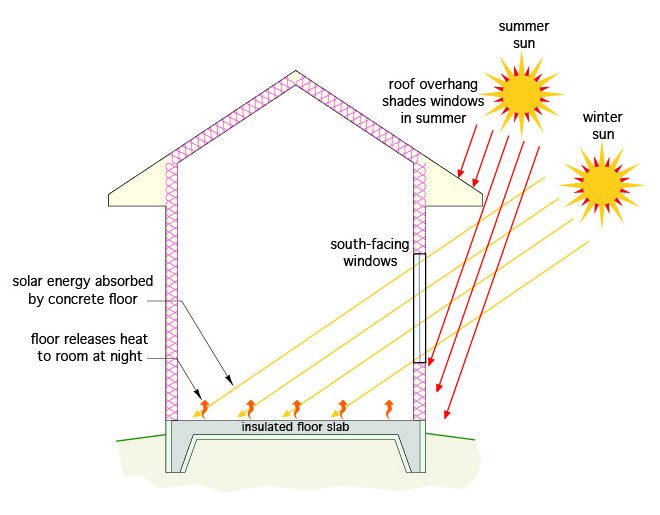
An appropriate amount of eave overhang allows the rays from the low winter sun into the building while blocking the more overhead rays in the summer. In this way, heat gain is maximized in the winter and minimized in the summer.
Passive solar systems can also be used to heat domestic hot water, as seen in Figure 2.
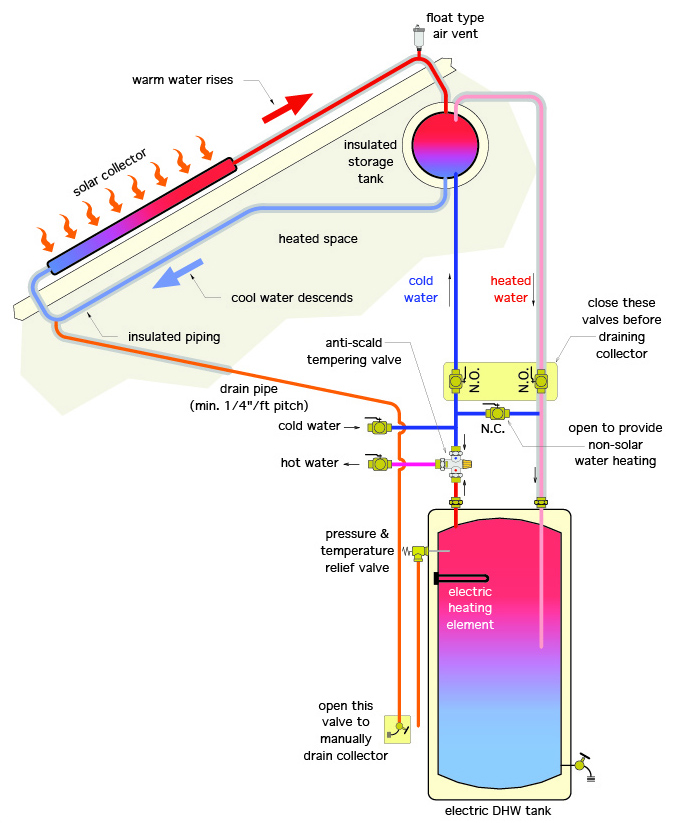
A sloped solar collector is mounted below an insulated storage tank. When the sun’s rays warm the water in the collector, it expands in volume, becomes less dense and is pushed upward by gentle convection currents created by the cooler water below it into the insulated tank. This is known as “thermosiphoning”. As long as there is more heat in the collector than in the storage tank, this process will continue. Once the sun sets, or at any time where the temperature in the collector falls below that of the tank, the flow stops. These systems work well in warmer climates where the possibility of freezing is minimal or non-existent, but in colder climates, the collector and any parts of the system that may freeze must be drained. Figure 4 shows the insulated storage tank as a pre-heater for the electric water heater. This can reduce the energy costs caused by the electric elements. If water temperatures higher than 140°F (60°C) are expected, a thermostatic mixing valve must be installed to avoid scalding water from reaching any plumbing fixtures. High temperatures are possible in any type of solar water system, especially in times of prolonged sunny weather, especially if hot water demand is low.
Active Solar Thermal Systems
Any system that uses a circulator to move a fluid through a solar collector is known as an active solar thermal system. The use of a circulator (pump) to move water through the collector makes the design considerations of these systems almost limitless. We will focus our study of solar thermal systems on those using water or liquid as the heating medium, and we will start by looking at the heart of the system, the collector.
Solar Collectors
There are two main types of solar collectors used in domestic hot water and space heating; flat plate type and evacuated tube type.
Flat Plate Collectors
Flat plate type collectors have been on the market for many decades and can also be home-built. They are essentially many small-diameter copper tubes that are bonded to a copper sheet and run vertically within the housing between an upper and lower header, as shown in Figure 3.
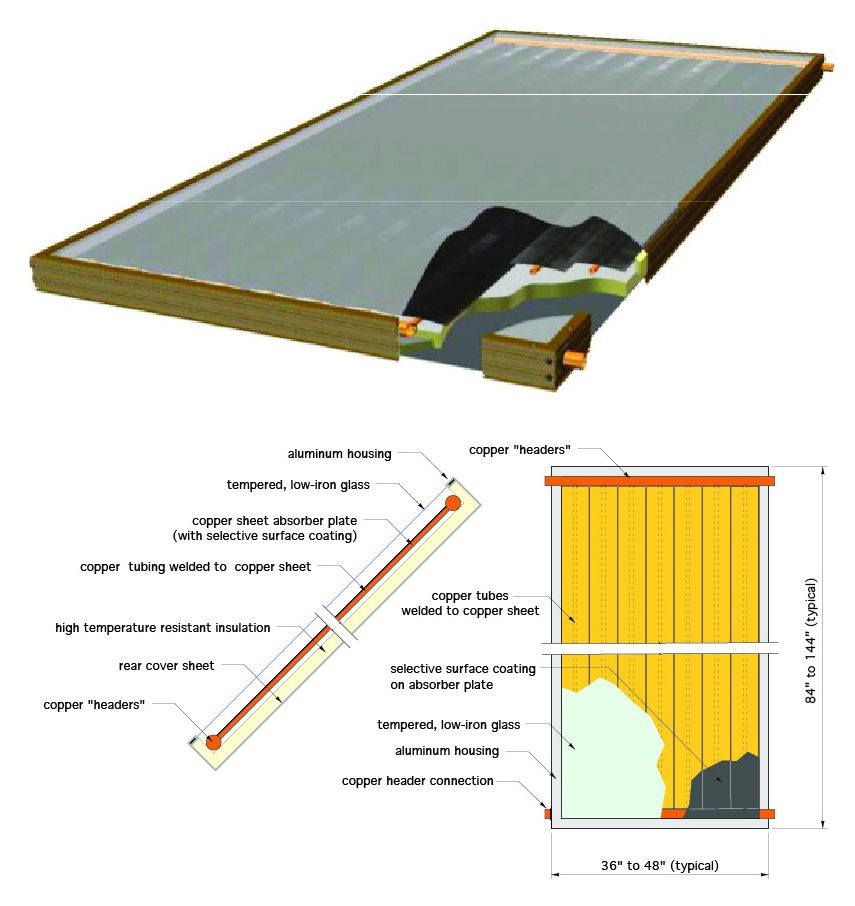
The copper sheet absorbs the sun’s heat and transfers it to the copper tubes. The thermosiphon principle moves the heated water to the upper header where it is pumped out to the system. The heat-absorbing feature of the copper sheet is augmented by painting or electro-plating with a matte black finish. The assembly of headers, tubes and sheet are contained within an aluminum frame having a high-impact tempered glass cover and high temperature insulation between the back of the copper sheet and the back of the frame. All materials have to be capable of withstanding temperatures in excess of 350°F (177°C) on days where there is minimal or no water flow through the collector. As well, the collector must withstand the impacts from hailstones and other objects. Flat plate collectors have been used for many decades and, due to their simple design, are capable of being fabricated on-site.
Evacuated Tube Collectors
Evacuated tube collectors are a series of glass tubes inserted into a special header. Each tube consists of an inner and an outer glass shell, with the atmosphere removed from the space between them, which makes it operate similarly to a Thermos® bottle. Inside the inner glass tube is a sealed copper tube that has a special liquid inside it. When exposed to sunlight, the liquid in the copper tube vapourizes and rises to the top of the tube, where the heat of the vapour is transferred via conduction through a copper “cap” to a sealed socket in the liquid-filled header. The header’s liquid, which can be either water or a water-glycol mixture, is then moved through the system by pumps. There is only one header at the top of the tubes, with inlet and outlet at opposite ends.
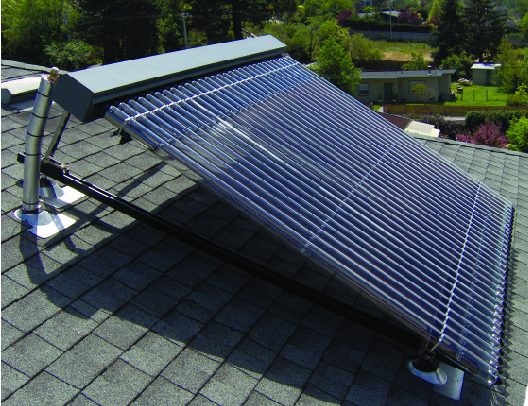
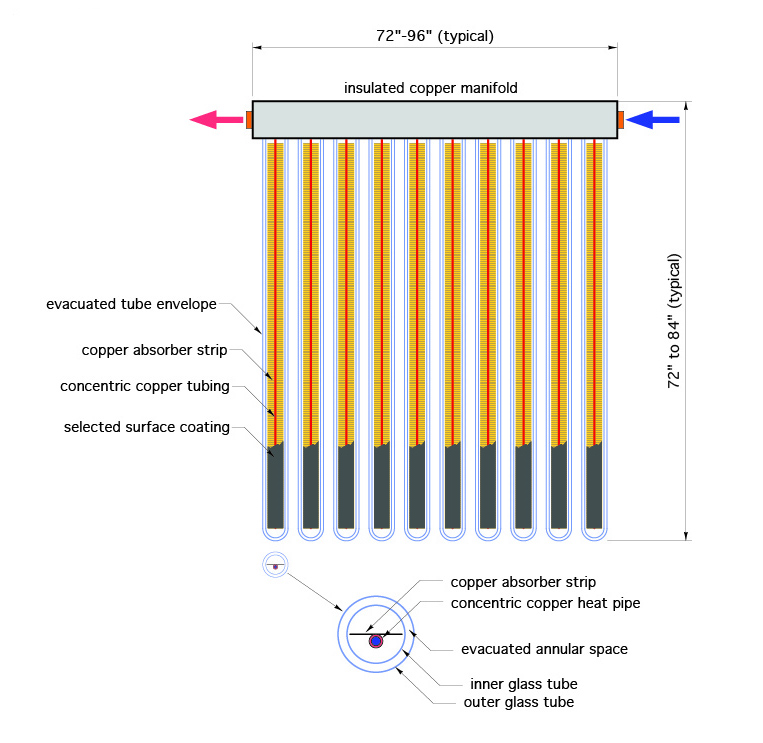
It is important to note that the liquid in the tubes never mixes with the system liquid within the header. When the vapour in the tube cools, it condenses and falls back to the bottom of the copper tube, ready to repeat the cycle. Headers can be “ganged” together for extra capacity, and piped similarly to heat transfer units in a hydronic heating system. If a tube is damaged, it is simply pulled from the header and replaced; the “socket” that the tube is inserted into is sealed to the header.
Swimming Pool Solar Collectors
One of the most common residential uses of solar energy is in the heating of swimming pool water. These collectors are normally of the uninsulated, unglazed flat plate variety, made of UV-stabilized polymers that are compatible with the pool water’s chemistry. A sheet of small-diameter plastic tubes is connected to an upper and a lower header and is laid on a flat surface such as a roof, with no insulating material between them. Their design is similar to that of a flat plate collector, with the exception that there is no enclosure around the headers or tube sheet.

Ideally, the roof would be angled appropriately to as close to its optimum summertime declination as possible, but in most cases, these collectors are placed wherever there is roof space available that has exposure to the sun. Unlike the flat plate or evacuated tube collectors, the polymers of pool collectors have a low thermal conductivity. They operate on a low temperature differential (ΔT), and a high volume of water must pass through them in order to increase the water’s temperature by a degree or two. Consequently, much more surface or “wetted” area is needed than the other two types of collectors mentioned in earlier text. Those operate on a much higher ΔT and so require less surface area and volume. Swimming pool collectors operate by passing the pool water directly through them, so there is no need for any type of heat exchanger.
Solar Collector Performance
Solar system designers look to collector manufacturers for data that reflects the output of their products. The makers of solar collectors have data available that express the thermal efficiency of the collector as a numerical value. This value is a ratio of the instantaneous heat output of the collector divided by the rate solar radiation strikes the panel. This is similar to the expression of thermal efficiency used by boiler manufacturers, in that it states the desired output quantity (collected heat) as a percentage of the required input quantity (solar “fuel”). However, unlike a boiler, there are more conditions that can change, which will affect the collector’s thermal efficiency, such as fluid inlet temperature, the ambient air temperature and the intensity of the solar radiation striking it. These conditions can be plotted on a graph, with the horizontal axis reflecting the “inlet fluid parameter”, expressed as the result of the following equation: [latex]p=\dfrac{{T}_{i}-{T}{a}}{I}[/latex] where:
- Ti = inlet fluid temperature to the collector in °F
- Ta = ambient air temperature surrounding the collector in °F
- I = solar radiation intensity striking the collector in Btu/hr/ft²
The greater the value of the inlet fluid parameter, the more severe the conditions under which the collector operates, and the lower its thermal efficiency.
Figure 7 shows one graph that is used for determining the efficiency of a solar flat plate collector. We’ll use it in the following example.
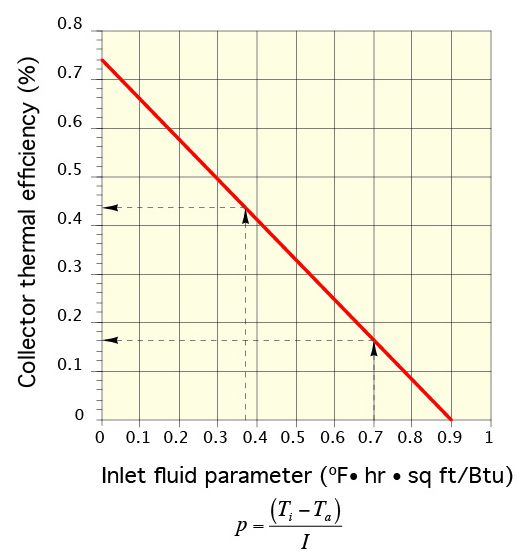
For our example, let’s assume that:
- Inlet water temperature to the collector is 160°F
- Ambient air temperature is 20°F
- Intensity of solar radiation striking the panel is 200 btu/hr/ft²
Figure 8 below is a graph that is representative of the amount of direct solar radiation that might be expected at a geographical location lying at 40° north latitude, dependent upon summer versus winter and at different times of the day. At noon, when the sun is most directly above the collector, that panel may generate as much as 300 btu/hr/ft² of collector surface. Panels in lower latitudes can expect to peak at higher outputs whereas panels in Canada, which are above the 49th parallel line of latitude, can expect a lower output value.
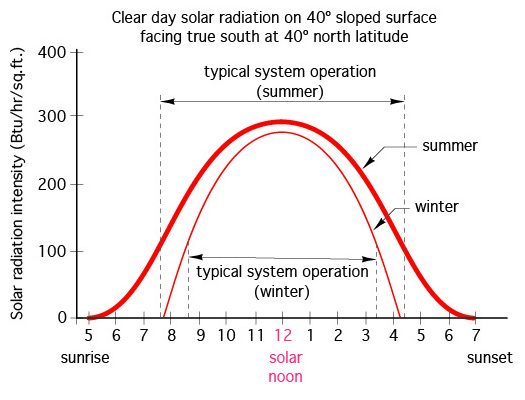
For our example conditions above, using the formula below, the inlet fluid parameter would calculate to be: [latex]p=\dfrac{160-20}{200} \qquad p=0.7[/latex]
To find the efficiency of that particular panel at that inlet fluid parameter, enter the graph in Figure 7 at 0.7 on the horizontal axis. Follow a vertical line up to intersect the diagonal red line, then read horizontally left from that point to a value on the vertical axis. The reading arrived at is approximately 0.16 or 16%. This means that, under the aforementioned operating conditions, only 16% of the direct solar radiation striking the panel is converted to a useable heat output. This low efficiency is due to the unfavourable operating conditions, such as forcing the collector to operate with a relatively high inlet water temperature during cold outdoor conditions.
For comparison, we’ll change only one of the operating conditions, namely the inlet water temperature. If the same collector (hence same graph) has an inlet water temperature of 95°F and unchanged ambient air temperature and solar radiation intensity, the equation becomes: [latex]p=\dfrac{95-20}{200} \qquad p=0.375[/latex]
Plotting 0.375 on the horizontal axis, and projecting up to the diagonal line and over to the vertical axis, the efficiency rises to approximately 0.42 or 42%. The significant drop in the inlet fluid temperature results in a much higher thermal efficiency. This demonstrates that collector efficiency is extremely dependent upon inlet fluid temperature. For best performance, the inlet fluid temperature to a collector should be kept as low as possible.
In Canada, building codes reference two publications that a solar system must conform to. They are:
- CSA F378 “Solar Collectors”, and
- CSA F379 “Solar Domestic Hot Water Systems (Liquid to Liquid Heat Transfer)
Anyone wishing to install a solar thermal system must satisfy the local Authority Having Jurisdiction that the equipment meets or exceeds the performance criteria laid out in those publications.
Which Collector is Best?
There is no simple answer to this question. To make any accurate comparisons between collectors, one would have to consider many factors such as differences in roof area requirements, maintenance requirements, ability to shed snow, freeze protection options, water temperature required, aesthetics and, no doubt, initial cost. From the standpoint of thermal performance only, the collector with the best performance depends upon the temperature required by the system it supplies.
The graph in Figure 9 represents a sampling of performance ratings of different types of collectors as compiled by the SRCC (Solar Rating and Certification Corporation) who are the US counterpart to CANREA (Canadian Renewable Energy Association). CANREA are a not-for-profit association of manufacturers and industry partners who provide guidance and certification for companies and authorities in Canada involved in solar and wind technology. The graph shows that the collector with the highest thermal efficiency depends on the value of the “inlet fluid parameter”, which was discussed earlier.
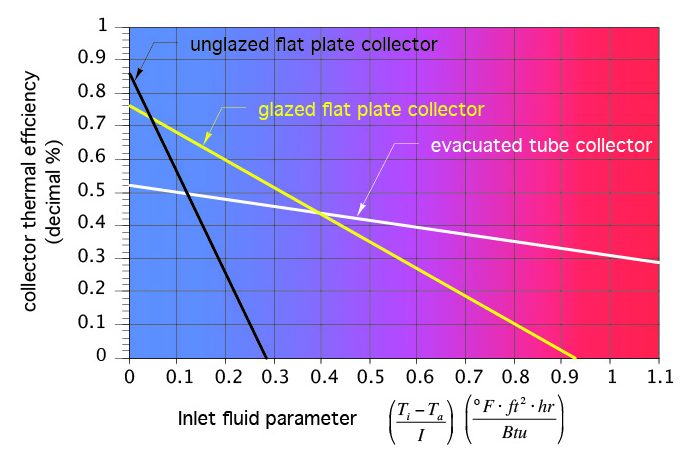
The graph indicates that, if the inlet water temperature is at or just above the ambient air temperature, such as with a swimming pool, an unglazed, uninsulated flat plate collector will provide the highest thermal efficiency. However, as the load temperature increases, an unglazed collector rapidly loses efficiency relative to a glazed, insulated collector. At even higher inlet temperatures, the better-insulated properties of the evacuated tube collector propel it past the glazed flat plate collector for efficiency.
Truly, the only way to accurately compare seasonal performance in collectors is through the use of computer simulation software based on a specified load in a specified climate.
Stagnation Conditions
In situations where there is bright sun but no flow through the collectors, such as in a power outage or through a system component malfunction, the collector is said to be “stagnating”, and can reach internal temperatures of 350°F or more. This can cause any plastic components in the piping to fail, so copper tube has long been the piping material of choice. As well, prolonged stagnation can cause the breakdown of glycol-based anti-freeze solutions, so some active systems employ a “self-dump” feature that will automatically drain the collector if excessively high temperatures due to stagnation are sensed.
Now complete Self-Test 1 and check your answers.
Self-Test 1
Self-Test 1
- What is the type of radiation that strikes the earth’s surface and is easy to reflect using mirrors?
- Direct
- Diffuse
- Delinear
- Deflected
- What is the type of radiation that is reflected in every direction due to particles in the air, and that cannot be easily reflected?
- Direct
- Diffuse
- Delinear
- Deflected
- Which one of the following can be viewed as the position or change in the sun’s path across the sky in the different seasons?
- Solar azimuth angle
- Solar altitude angle
- Solar declination angle
- Magnetic declination angle
- Which one of the following is measured from true north in a clockwise direction, with the south pole being 180°?
- Solar azimuth angle
- Solar altitude angle
- Solar declination angle
- Magnetic declination angle
- What is the difference between compass-indicated north/south and “true” (polar) north/south known as?
- Solar azimuth
- Solar altitude
- Solar declination
- Magnetic declination
- Which one of the following choices best describes the type of system that might use large south-facing windows and bare concrete floors to absorb heat during the day and release it at night?
- Active
- Passive
- Direct-gain active
- Direct-gain passive
- What is the term known as whereby heat from the solar storage tank is lost to the collectors through convection currents?
- Thermosiphoning
- Respiration
- Conduction
- Radiation
- What is the term given to any system that uses a circulator to move a fluid through collectors?
- Passive thermal
- Active thermal
- Passive photovoltaic
- Active photovoltaic
- What type of finish on the tubes and sheets helps with the collection of heat by a flat plate solar collector?
- Brushed chrome
- Bright white
- Black matte
- Unfinished
- What type of solar collector is built somewhat like a Thermos® bottle?
- Flat plate
- Home built
- Evacuated tube
- Solar-declinated
- What type of installation is well-suited to the use of collectors that are of the unglazed, uninsulated flat plate UV-stabilized polymer variety?
- Hot water tank
- Swimming pool
- Space heating
- Greenhouses
- What collector criteria is the result of an equation that factors in the collector inlet fluid temperature, ambient air temperature and solar radiation intensity?
- Inlet fluid parameter
- Outlet fluid parameter
- Inlet collector perimeter
- Outlet collector perimeter
- At what time of day is solar direct radiation the strongest, no matter what the latitude of the location?
- 10 am
- 12 pm
- 2 pm
- 5 pm
- Which one of the following contributes most to achieving the best collector performance?
- High collector outlet fluid temperature
- Low collector outlet fluid temperature
- High collector inlet fluid temperature
- Low collector inlet fluid temperature
- What is the term given to a high-temperature situation in the collectors that is caused by unusually high sustained direct radiation and low flow conditions?
- Radiation
- Stagnation
- Conduction
- Stratification
Check your answers using the Self-Test Answer Keys in Appendix 1.
Media Attributions
- Figure 1 Passive building heating © Caleffi Hydronic Solutions. Used with permission.
- Figure 2 Passive solar DHW system © Caleffi Hydronic Solutions. Used with permission.
- Figure 3 Flat plate collector © Caleffi Hydronic Solutions. Used with permission.
- Figure 4 Evacuated tube collector in position © Caleffi Hydronic Solutions. Used with permission.
- Figure 5 Evacuated tube collector © Caleffi Hydronic Solutions. Used with permission.
- Figure 6 Swimming pool collector © Caleffi Hydronic Solutions. Used with permission.
- Figure 7 Efficiency graph for a solar flat plate collector © Caleffi Hydronic Solutions. Used with permission.
- Figure 8 Example of intensity of solar radiation at a location at 40° north latitude © Caleffi Hydronic Solutions. Used with permission.
- Figure 9 Efficiency comparisons of collector types © Caleffi Hydronic Solutions. Used with permission.

